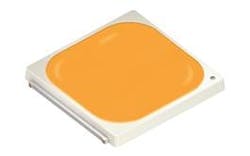Osram delivers COB LED alternative in an SMD mid-power package (UPDATED)
The Duris S 10 LED family from Osram Opto Semiconductors has a 7.7-mm LES, enabling the device to replace low-power COB LEDs while lowering SSL system costs through automated lighting product assembly techniques.
Osram Opto Semiconductors has announced the Duris S 10 packaged LED family offering high-power LED flux output levels in a mid-power-like package that the company said can be used in place of chip-on-board (COB) LEDs. The LEDs enable solid-state lighting (SSL) manufacturers to use automated surface-mount-device (SMD) printed circuit board (PCB) assembly techniques for light engines, thereby enabling lower overall system cost while the high output from a 7.7-mm light-emitting surface (LES) targets demanding applications including downlights.
The Duris family of LEDs from Osram has been primarily a mid-power LED family based on plastic packages although it increasingly spans a broader application and performance range. Most recently at LightFair International (LFI), Osram had added the Duris S 2 family with a volumetric phosphor approach for linear lighting and a package almost akin to a chip-scale package (CSP). The company had also added 90-CRI capabilities in the Duris S 5 packaged LED family for use in more demanding SSL applications such as retail.
The Duris S 10, however, stretches the mid-power concept considerably in terms of size and lumen output. The LEDs measure 7×7 mm, although Osram characterizes the LES as having a 7.7-mm diameter. In reality, the Duris S 10 LES is more square with rounded corners in shape than circular, although the maximum diagonal measures 7.7 mm. At launch the company will offer the LEDs in 1050- and 1400-lm versions for 3000K-CCT LEDs driven at 300 mA and operated at 85°C. That puts typical efficacy in the 125 lm/W range. CRI is 80 maximum for now.
Osram calls the Duris S 10 Chip Array SMD (CAS) products. The terminology refers to the fact that there are multiple emitters connected in an array within the package and that SSL products using the components would be assembled using automated SMD techniques. The architecture is electrically and optically similar to a small COB LED, with neither type of device sporting a primary optic. But COB LEDs would typically be assembled manually via solder connections or specialized holder/connector devices.
Many COBs would presumably have a superior thermal design via a thermally-enhanced substrate upon which the array is constructed. But Osram said the Duris S 10 can handle challenging environments. "As this LED was intended for use in high-temperature environments such as downlights and retrofit lamps, the package technology employed is a glass-fiber-enhanced epoxy silicone resin package, which has a high tolerance to heat and ultraviolet," said Marc Dyble, marketing and business development manager for general lighting at Osram.. "This stable package material is the same material used in our Duris S 5 mid-power LED and offers a superior lumens/dollar option over COB packages."
The package is an enhancement to what is often called an epoxy molded compound (EMC) package. Dyble said the thermal resistance of 1.2K/W is very similar to typical COB packages. He also noted that system designers must, as always, follow good thermal design practices when using the packaged LED.
The Duris S 10 LEDs are high-voltage devices meaning that the individual emitters within the package are connected in series, or more likely a parallel set of series emitted strings. The 1050-lm packaged LED has a forward voltage of 28V and the 1400-lm device has a forward voltage of 37V. Such higher-voltage LEDs can simplify the LED drive design by lessening the voltage gap between the line input and the LED.
Osram says the new LEDs are a good match for spotlights, downlights, and retrofit lamps in cases where a single LED can output the required lumen level. Moreover, the company touts the beam angle. "With typical luminous flux packages of 1050 and 1400 lumens and a light-emitting surface of only 7.7 mm in diameter, the new Duris S 10 forms the basis for compact optics and extremely narrow beam angles," said Dyble.
Note, however, that you can get similar flux output from a much smaller LES area with high-power LEDs in ceramic packages, and better beam control. Indeed, Cree has long touted the beam-control advantages of smaller sources and primary optics, referring to the advantage as superior optical control factor.
Osram doesn't make the outright point in the Duris S 10 announcement, but clearly the LEDs are intended for cost-reduced applications over high-performance applications. At launch, Osram did not specify the projected lifetime of the new LEDs, and the data sheet posted on the company's website fails to address the issue as well.

Maury Wright | Editor in Chief
Maury Wright is an electronics engineer turned technology journalist, who has focused specifically on the LED & Lighting industry for the past decade. Wright first wrote for LEDs Magazine as a contractor in 2010, and took over as Editor-in-Chief in 2012. He has broad experience in technology areas ranging from microprocessors to digital media to wireless networks that he gained over 30 years in the trade press. Wright has experience running global editorial operations, such as during his tenure as worldwide editorial director of EDN Magazine, and has been instrumental in launching publication websites going back to the earliest days of the Internet. Wright has won numerous industry awards, including multiple ASBPE national awards for B2B journalism excellence, and has received finalist recognition for LEDs Magazine in the FOLIO Eddie Awards. He received a BS in electrical engineering from Auburn University.






